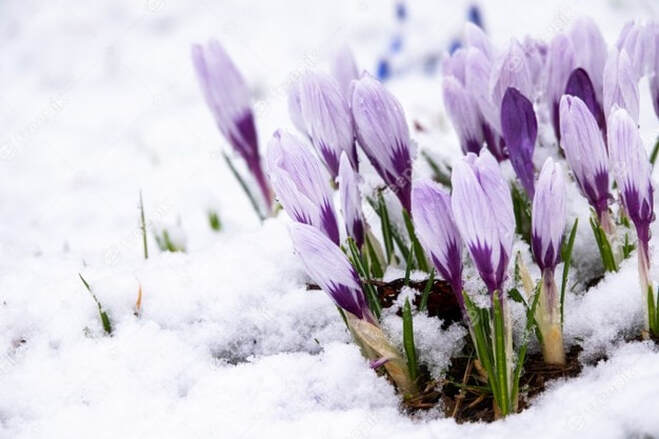How Do Pollinators Spend the Winter?
Actually, various pollinator populations have devised unique and impressive strategies to cope with the cold weather. Birds fly south for the winter. Monarchs and a few other species of insects migrate as well. However, for the most part, native bees, butterflies, moths, beetles, and other insects stick close to home and take advantage of their native territory while they take a well-deserved vacation over the colder months. They burrow underground or make a nest inside a hollow woody stem, or maybe find an attractive ground cover of leaves or a woodpile to claim as their winter home.
The cooler temperatures and shortening days trigger the insects’ instinct to start putting on fat and getting rid of excess water. When the time is right, they seek a dry, covered shelter and enter a state of hibernation called diapause where their metabolism drops, allowing them to enter a state of suspended animation and sleep through the winter. Diapause may occur in any life cycle stage — embryonic, larval, pupal, or adult — depending on the insect species.
In some varieties of bees, butterflies, and moths, the adults die but not until they have securely provisioned a safe haven for the next generation. Many native bees lay eggs in underground nests or in sealed cavities above ground. The eggs hatch into developing pupae or dormant adults and wait until spring to emerge. For butterflies and moths, strategies include surviving the winter in cocoons or as caterpillars. Some can even survive as mature adults protected from the elements by tall grasses or ground cover.
Fascinating note: Woolly bear caterpillars can slow down their bodily functions and freeze rock solid. As the weather warms, they thaw out and crawl off as if nothing happened!
Bumblebees have a unique take on perpetuating their species. As winter approaches, future queens mate with male bumblebees from different colonies. She consumes as much nectar and pollen as possible to build up her fat reserves before retiring to her underground lair to hibernate while the rest of the colony succumbs to the cold. Then, in spring, she awakens and locates a new nesting site and starts a brand new colony of her own.
Honeybees have an even more unique approach to surviving the winter. They form a cluster inside the hive and stay in perpetual motion. Worker bees (all females) gather around their queen and vibrate their wings and bodies to generate heat. They circulate through the cluster so the girls on the outside have an opportunity to spend some time in the warmer center. This continues all winter long.
On super cold nights the outer bees sometimes freeze to death and fall to the hive floor. Even so, that doesn’t stop the others from fulfilling their task. This never-ending dance takes a lot of energy. The hard-working bees are fueled by the honey stored in the hive. They take time to eat but not much else, including going potty. Honeybees don’t like a messy hive, so they won’t “go” until a warm day allows them to break cluster and leave the hive. Then they make a bee-line for the exit! While they’re at it, the honeybees forage for nectar and pollen sources. They will visit flowering shrubs and trees, as will some native bees taking advantage of the warmer temperatures (above 55 degrees).
You can help them out by providing some plants and trees that bloom in the winter.
Foliage in the Winter
As early as January, there are days when the sun’s warmth lures you to follow your nose through the door and into the great outdoors to enjoy the beautiful weather. It has the same effect on the bees as well. They want to escape the confines of their nest or hive and go exploring. Having some shrubs, flowers, and trees sprucing up your landscape would be an excellent way to help our winged friends.
Many perennials, annuals, and shrubs actually bloom in the coldest months of the year. Pollinator plants like crocus and primrose bloom even when snow covers the ground. Trees and shrubs also are great choices for feeding the hungry early risers. Willows, maples, filberts, and hazelnuts are excellent late winter/early spring sources of pollen.
Check your USDA Hardiness zone to make sure the native plants you choose will survive the dipping temperatures where you live. Perennials and shrubs need to be planted before the ground freezes so they can get their roots established. However, you can grow hardy annuals such as pansies and violas in milder climates for much of the winter.
Some other flowering plants and shrubs to consider for winter color and pollinating insects include:
- Higan Cherry (Winter Flowering Cherry)
- Witch Hazel
- Winter Jasmine
- Burkwood Viburnum
- Sweet Box
- Aster
- Beautyberry
- Hellebores
- Pieris
- Winterberry
- Winter Aconite
- Cyclamen
- Camellia
- Leucojum
The pollinators are out there, no matter where you are — the mountains, coastal regions, prairies, or anywhere in between. Some will be snoozing right under your feet or living in the tree and leaf litter scattered around your yard this winter. Watch for them to sneak out of hiding on a warm day. Chances are you’ll see a few bees or maybe even a moth or butterfly investigating the foliage. They’re just as anxious for spring as you are!
Sweet & Sassy Scribblers … on Conservation

 RSS Feed
RSS Feed

